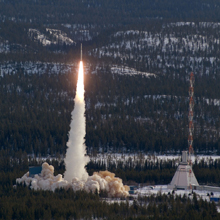 |
| One of the cameras that the space centre uses at the base is the AXIS Q6035-E, designed for extreme climates |
Esrange Space Centre has chosen Axis Communications’ cameras to give it a better overview of on-site operations and to improve safety.
Esrange Space Centre is a rocket range and research centre located above the Arctic Circle in the north of Sweden, near the mining town of Kiruna. It is owned by SSC, a comprehensive space industry active in many fields of space technology and services, and the base launches sounding rockets and high altitude balloons for scientific research purposes.
Safety is paramount at the Esrange Space Centre and it has therefore chosen to use Axis’ IP cameras, installed by Axis partner Insupport Nätverksvideo, to get a better operational overview of the base.
“We have used Axis cameras for different purposes in the past, and when we decided to integrate cameras into our safety system, all suppliers we contacted recommended Axis cameras. In other words, it wasn’t a difficult decision for us”, says Martin Hedqvist, project manager at Esrange Space Centre.
The principal reason for this investment is to improve safety at the space centre; however, a large proportion of the investment is to make day-to-day operations more transparent and accessible to the public. Now, thanks to the Axis cameras, anyone can follow daily operations from various different base locations via online live streams.
“With the new camera setup, our head of Operations can get a much better overview of our site operations and see exactly what’s happening at the launch ramp right before every launch”, continues Martin Hedqvist.
One of the cameras that the space centre uses at the base is the AXIS Q6035-E, a camera that is perfectly designed for extreme climates so the cold, Arctic winds are not a problem.
“With AXIS Q6035-E cameras in place, you don’t have to worry about weather conditions. The cameras can withstand temperatures as low as –40 Celsius, and we have even tested it at an altitude of 35,000 metres, where it gets far colder than that!” Concludes Fredrik Thor, sales manager at Axis Communications.


















